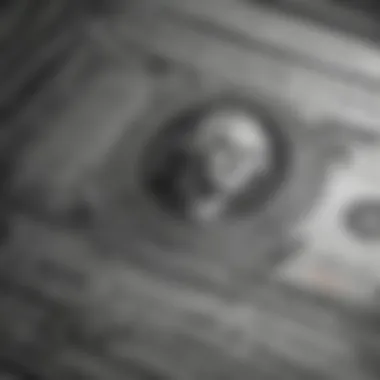Exploring the Market for Silver Certificates


Intro
When discussing investments that thrive beyond traditional markets, silver certificates stand out, intertwined with both history and monetary complexities. However, before diving into selling them or even understanding their value, it’s crucial to grasp the contours of investment terminology. For many investors, silver certificates are unfamiliar territory, often shrouded in obscurity yet laden with potential.
To sell effectively in this arena, investors need to arm themselves with pertinent knowledge—fundamental definitions, key concepts, and strategic insights that can turn a simple transaction into a profitable venture. With a market that fluctuates based on various economic factors, knowing the intricacies of silver certificates is not just advantageous but indispensable.
This article will unravel the essential investment terminology, delve into expert advice, and navigate through the current landscape of silver certificates, ensuring you are well-equipped to make informed decisions along the selling journey.
Foreword to Silver Certificates
The notion of silver certificates carries a weight that intertwines history, economy, and the intricate web of finance. Understanding this concept is crucial, especially for individual investors and financial enthusiasts who tread the sometimes murky waters of precious metal investments. Silver certificates are not merely pieces of paper; they represent a unique financial instrument that reflects the value and stability of silver in the market.
In this exploration, it becomes important to grasp how these certificates arose, their role in the past, and how they fit in today’s financial landscape. They have served as a medium of exchange, often equated to tangible silver, providing a level of convenience and security during certain epochs in history. Moreover, the selling of these certificates has its nuances, influenced by market demand, collector interest, and fluctuating prices of silver.
Historical Background
To truly appreciate the silver certificate, one must first journey into its historical roots. Introduced in the late 19th century, these certificates were initially issued by banks as a promise to pay the bearer the equivalent in silver on demand. This practice sprouted from the need for a more portable and convenient method of trade compared to lugging around heavy silver coins.
In 1933, during the Great Depression, the U.S. government transitioned these certificates, essentially calling for their redemption. The certificates began disappearing from circulation, becoming collector's items rather than common currency. Historically, their value soared, especially during times of economic instability, when investors sought safer assets.
"Silver certificates provide a unique glimpse into our economic history, serving both as currency and as a reflection of the era's financial beliefs."
Significance in Modern Finance
Fast forward to the present, the story doesn’t end there. Silver certificates have made a notable comeback in niche investment circles. Their rarity and historical significance contribute to their allure. For modern investors, these certificates often serve an additional purpose; they’re seen as a hedge against inflation and market downturns.
As the economy fluctuates, the tangible asset that silver represents continues to hold intrinsic value. The interplay between silver prices and certificate values creates opportunities for savvy investors. Understanding this dynamic opens doors for informed decision-making.
In summary, an overview of silver certificates is key in understanding the broader context of the financial market regarding precious metals. Their journey from widely circulated currency to collectors' items highlights shifts in financial stability and investor confidence, making them a compelling topic for discussion in today’s economic climate.
Understanding Silver Certificates
When diving into the world of silver certificates, it’s vital to grasp just what they are and why they matter in the broader spectrum of finance and investment. This section unpacks the nuances surrounding silver certificates, shedding light on their definition and types, and guiding you toward making more informed decisions.
Definition of Silver Certificates
Silver certificates are essentially a form of paper currency that represents a specific amount of silver stored in a vault. Initially, these certificates were issued by the U.S. government as a means to back up the paper currency with tangible silver reserves. In a time when people primarily used coins and bullion, silver certificates provided a more practical way to transact. They allowed holders to exchange their certificates for an equivalent amount of silver, hence acting as a bridge between physical assets and currency.
The importance of understanding silver certificates lies not just in their historical context but also in their role in the current market. They often carry intrinsic value based on the amount of silver and their rarity. Collectors and investors should know how to identify genuine silver certificates and understand the implications of ownership.
Types of Silver Certificates
Silver certificates can primarily be categorized into two types, which reflect their historical issuance and valuational characteristics:
- Old-Type Silver Certificates: These include the certificates issued before 1964, particularly those that state "for silver dollar" or "payable to the bearer on demand in silver" on them. Their aesthetic appeal, featuring intricate designs and notable figures, tends to attract collectors. Older series such as the 1896 and 1899 issues are particularly sought after due to their rarity and artistic design.
- Modern-Type Silver Certificates: Issued after 1964, these certificates come in different forms, mainly backed by government reserves. Though not as famous as their older counterparts, modern silver certificates still hold value, especially for those who understand the nuances of the numismatic community. Their value often hinges on their mint condition and demand among investors.
The Valuation of Silver Certificates
Understanding the valuation of silver certificates is crucial for anyone looking to navigate this financial instrument effectively. The value of these certificates is not only a reflection of the inherent silver content but also encompasses historical context, collector interest, and prevailing market trends. For individual investors and collectors alike, grasping how value is determined can mean the difference between a satisfactory sale and a missed opportunity. This section aims to delineate the various facets that contribute to the valuation process, providing a robust foundation for making informed decisions.
Factors Influencing Value
The value of silver certificates can fluctuate based on several factors. Firstly, one must consider the rarity of the certificate itself. Older certificates or those printed in limited quantities tend to command higher prices due to their collectible nature. For example, the 1896 $1 silver certificate featuring the allegorical depiction of a woman’s likeness is often sought after by collectors, as it's both rare and visually striking.


Furthermore, the condition of the certificate plays a significant role in valuation. Certificates are graded on a scale from "Poor" to "Gem Uncirculated." A certificate in mint condition will fetch a premium over one marked as heavily worn or damaged. Minor creases, discoloration, or stains can drastically reduce a certificate's value, so it’s crucial to store them properly to maintain their condition.
Market demand is another critical factor influencing value. When silver prices surge, the attraction toward silver certificates also tends to increase, as many buyers see them as a hedge against inflation. Conversely, in a market flush with cash, people may favor more liquid investments, which could impact demand for certificates.
Lastly, historical significance cannot be ignored. Certificates associated with particular events or market phases often gain additional value. For instance, any certificate that traces back to the Great Depression carries stories that add to its appeal and can justify higher price tags.
Market Trends and Future Predictions
Analyzing current market trends gives insight into potential future valuations of silver certificates. As the world grapples with inflation and economic uncertainty, many investors are finding solace in tangible assets like silver. This leads to a resurgence of interest in silver certificates, as they are seen as viable investment tools rather than mere collectibles.
Presently, silver prices are experiencing an upward trajectory, leading experts to predict that the value of silver certificates could also rise in the near future. According to financial analysts, if silver continues to strengthen due to supply-demand dynamics, certificates tied to physical silver will remain in high demand.
However, foreseeing the market isn’t without its challenges. It is imperative to consider the risk of market volatility. Prices may swing based on geopolitical tensions or shifts in monetary policy, which might impact both silver and silver certificates differently.
Collectively, those considering an investment in silver certificates must stay updated on market trends and incorporate them into their valuation considerations. Being aware of these trends not only helps in identifying the right time to sell but also assists in understanding how to enhance the value of one’s collection.
"As with any investment, knowledge is power, especially when it comes to understanding the intricate dynamics affecting value."
Legal and Regulatory Considerations
Selling silver certificates involves navigating a complex landscape of legal and regulatory frameworks. Understanding these factors is not just a matter of compliance but also crucial for making informed decisions. Failing to consider the government regulations and tax implications can turn a profitable sale into a legal minefield. This section delves into these aspects to shed light on why they matter significantly for anyone looking to sell silver certificates.
Government Regulations
When it comes to selling silver certificates, potential sellers should be aware of the regulatory framework that governs these transactions. In many jurisdictions, silver certificates are treated akin to physical silver or other forms of currency. As a result, sellers might have to adhere to specific rules designed to monitor and regulate sales to prevent fraud and money laundering. Lack of compliance can lead to hefty fines or even legal consequences.
A few key areas of focus in government regulations include:
- Licensing Requirements: Depending on local laws, you might need a dealer’s license to sell silver certificates, especially if you're dealing in bulk.
- Reporting Transactions: Some jurisdictions require reports for significant transactions, meaning you'll need to report the sale amount, the identity of the buyer, and the nature of the transaction.
- Consumer Protection Laws: These laws ensure that buyers are not misled during the purchase process. Sellers must present the silver certificates honestly, delineating their condition and value.
Understanding these regulations can save you from unforeseen issues down the line. It’s wise to consult with a legal expert or financial advisor who specializes in this field to ensure you’re fully compliant.
Tax Implications of Selling
Before selling your silver certificates, it’s crucial to look into the tax implications associated with those transactions. Selling any financial instrument can have consequences on your tax return, and silver certificates are no exception. Here are some important tax considerations to keep in mind:
- Capital Gains Tax: If you sell silver certificates for more than what you paid for them, you may be liable for capital gains tax. The rate can vary depending on how long you've held the certificates before selling.
- Short-Term vs. Long-Term Gains: If you held the certificates for less than a year, any gain from the sale might be subject to a higher short-term capital gains tax rate, which is usually equivalent to your ordinary income tax rate. Conversely, holding them longer could subject you to a more favorable long-term capital gains tax rate.
- Record-Keeping: It's imperative to maintain good records. You should document your original purchase price, any selling costs, and the sale price. Good record-keeping simplifies the tax-reporting process and helps substantiate your claims in case of an audit.
It's advisable to consult a tax professional who understands the nuances of silver and other investment-grade commodities. They can provide tailored advice based on your financial situation.
In summary, understanding legal regulations and tax implications is essential for anyone planning to sell silver certificates. Preparation in these areas can make the selling process smoother and more profitable.
Ensuring compliance with government regulations and accounting for tax implications assists not only in avoiding fines but also in optimizing returns on your investment.
Steps to Sell Silver Certificates
Selling silver certificates is a process steeped in both tradition and modern financial practice. Before embarking on the selling journey, it’s essential to understand the dynamics involved. This segment elucidates key components and benefits related to selling silver certificates, making it a critical exploration for anyone looking to navigate this market successfully.
Preparation for Sale
Getting ready to sell silver certificates is more than just having the certificates themselves. It requires a thorough understanding of what you’re selling. Here are the factors to consider:
- Documentation: Ensure that the certificates are valid and you have any accompanying documentation. This includes original receipts and any authentication that confirms their legitimacy.
- Condition Assessment: The physical condition of the certificate can dramatically affect its value. Look for creases, holes, and discoloration. A well-preserved certificate commands more attention from potential buyers.
- Research: Knowledge is power. Investigate current market trends, historical prices, and the reputation of your specific certificates to understand what buyers might be willing to pay. Reference articles on websites like Wikipedia or Britannica for deeper insights.
Determining the Right Selling Price


Setting the right price may feel like walking a tightrope. Too high, and buyers may shy away; too low, and you lose out on potential profits. Consider these pointers:
- Market Research: Check the latest auctions and sales to gauge current prices of similar silver certificates. Online marketplaces and forums like Reddit can provide insights from community discussions.
- Professional Appraisal: If you're unsure, seeking professional appraisal can offer a second opinion and validate your asking price.
- Pricing Strategies: Differentiate between asking price and bottom line. You might set a higher initial price to leave room for negotiation, while knowing your minimum acceptable offer.
Choosing the Right Marketplace
Not all marketplaces are created equal when it comes to selling silver certificates. Your choices can influence not only the price you receive but also the speed of sale:
- Online Platforms: Websites like eBay or AuctionZip cater to a wide audience and can provide quick sales. However, ensure you factor in seller fees when calculating potential profits.
- Local Coin Shops: Engaging local dealers might yield instant cash, plus an opportunity to establish a long-term relationship.
- Specialized Auctions: Participating in auctions that focus on collectibles or silver can attract knowledgeable buyers who appreciate the value of your certificates.
Negotiation Strategies
When it comes down to sealing the deal, effective negotiation skills are crucial. Here are some practical strategies:
- Be Prepared: Arm yourself with information about your certificates. Knowledge breeds confidence and can swing negotiations in your favor.
- Listen Actively: Pay attention to buyer concerns or inquiries. This insight can help tailor your responses and enhance trust.
- Stay Flexible: While you should have a firm bottom line, being willing to negotiate on price or terms can lead to quicker sales. Don’t be too rigid; sometimes, a little give can lead to big wins.
"In negotiations, the art lies not just in the offer but in knowing when to hold your ground and when to take a step back."
Mastering the steps to sell silver certificates will not only simplify the process but also maximize your financial return. With thorough preparation, accurate pricing, the right marketplace selection, and effective negotiation, you're better positioned to make a successful transaction.
Potential Risks and Challenges
Selling silver certificates is not just a walk in the park. In fact, understanding the potential risks and challenges involved is quite crucial for anyone looking to navigate this market. Ignoring these risks can lead to substantial financial losses, misunderstandings, or frustration when attempting to sell these unique items. Let’s break down some of the key considerations to keep in mind.
Market Volatility
One of the first things to know about silver certificates is that the market can be as unpredictable as the weather in spring. Prices fluctuate based on several factors, including overall economic conditions, the demand for physical silver, and even geopolitical tensions. For example, when investors are panicking about inflation or economic downturns, they typically flock to tangible assets like silver. This increased demand can quickly drive up prices, but conversely, if silver prices dip, so do the values of the certificates.
Because of this volatility, timing becomes a critical component. Selling at the wrong time can see you parting with your certificates for much less than their worth. Thus, keeping a keen eye on market trends and having a good grasp of economic indicators can be beneficial.
Counterfeit Risks
Another major concern involves counterfeit risks. As the saying goes, "not everything that glitters is gold." The world of collectibles and currency is rife with fakes, and silver certificates are not exempt. Counterfeits are particularly deceitful as they can look almost identical to genuine certificates, misleading even experienced sellers.
To safeguard against this, potential sellers should educate themselves on the characteristics of authentic certificates. Familiarizing oneself with details such as watermarks, serial numbers, and overall quality can be a lifesaver. Additionally, when engaging with buyers or collectors, it’s prudent to seek third-party verification from reputable sources or graders. This not only lends credibility to the sale but can also protect you from losing out due to fraudulent practices.
"The more you learn, the less you risk."
Mitigating these risks is about remaining informed and vigilant. By anticipating market fluctuations and being aware of counterfeit possibilities, sellers can make more educated and confident decisions. In the end, understanding these potential pitfalls can greatly enhance one’s selling strategy, leading to a smoother transaction experience.
The Role of Collectors and Investors
The market for silver certificates is not just about metal and currency; it involves a dynamic interplay between collectors and investors that can deeply affect the value and demand for these certificates. Understanding the roles of these two groups sheds light on the broader landscape of silver certificate sales and why they matter in both historical and contemporary contexts.
Collector Demand
Collectors have a unique relationship with silver certificates, viewing them not merely as economic instruments but as pieces of art and history. Silver certificates often come in various designs and series, appealing to enthusiasts who relish the challenge of finding rare examples.
When collectors seek out silver certificates, their motivations can range from a pure love of history to the potential for value appreciation. It's common to see collectors attend shows or engage in online forums to exchange knowledge and share tips on where to find valuable pieces.
- The appetite for specific series can swing based on trends. For instance, certain series, such as the 1896 $1 certificate known as the "Educational Series," have garnered significant attention due to their intricate designs and historical significance.
- Many collectors appreciate the narrative stories behind the certificates they own, adding personal value to their collections.
Furthermore, collector demand can indirectly raise market prices. As motivated enthusiasts go head-to-head for certain coveted items, the competition naturally drives prices upward. Therefore, understanding the collector landscape is crucial for anyone planning to sell silver certificates. Selling isn’t just a transaction; it’s tapping into a thriving community.


"The value of a silver certificate can sometimes hinge on its story, not just its historical context but the emotional connections collectors forge with it."
Investor Engagement
On the flip side of the coin, investors approach silver certificates with a distinctly financial mindset. Their assessments are often based on market trends, potential returns, and economic forecasting rather than historical appreciation. This group varies widely in their knowledge and strategies, ranging from casual investors who buy as a hedge against inflation to seasoned financial professionals who look at silver certificates as a part of a diversified portfolio.
Investors are increasingly attracted to silver certificates as silver itself gains traction as a valuable asset. Factors influencing their engagement include:
- Market Performance: Current global economic conditions can heavily influence investment decisions, particularly during times of uncertainty. Silver is often viewed as a safe haven, and its valu can rise amidst instability.
- Liquidity Considerations: Investors typically prefer certificates that can be easily sold or traded. This is a critical factor when deciding which types of silver certificates to purchase.
- Engagement with Trends: Investors are keen observers of market analytics, and they are quick to adapt to shifts in demand or value—whether due to collector interest or broader economic trends.
Investor engagement in the silver certificate market can lead to increased stabilization of prices, making it an appealing venture for those looking to maximize financial returns. For sellers, understanding this segment of the market is essential, as the strategies and knowledge investors bring can significantly influence how certificates are valued.
Long-Term Perspectives on Silver Investments
The perspective on silver investments and their long-term viability is crucial within the landscape of financial planning. It stands out as an opportunity for both individual investors and collectors to diversify their portfolios while taking advantage of precious metal trends. This section explores the perspectives of those venturing into silver, addressing key benefits and considerations regarding long-term holdings of this unique asset.
Comparative Analysis with Other Investments
When comparing silver investments to other assets such as stocks or real estate, silver has some distinct advantages. Here are a few points to ponder:
- Inflation Hedge: Unlike paper currency, silver has intrinsic value, often holding or increasing its worth during inflationary periods. This means while cash slowly loses its purchasing power, silver can serve as a safeguard.
- Market Correlation: Silver often has a low correlation with stock market performance, providing a buffer in volatile markets. When the equities rally, silver may lag or even decline, but when the markets take a nosedive, silver might shine a bit brighter.
- Liquidity: Many silver certificates, unlike some collectibles, can be converted into cash with relative ease, making them a practical choice for those looking for both a long-term hold and an accessible asset.
However, it’s essential not to overlook the risks:
- Market Manipulation: In this space, silver's market can sometimes be vulnerable to manipulation, causing volatility and unexpected pricing swings.
- Costs of Storage: While silver certificates are convenient, the underlying asset still needs safety measures for physical storage if ever converted. This sparks additional costs which should be factored into the investment.
The decision to diversify with silver should be made cautiously, weighing these elements carefully against other investment opportunities.
Historical Performance Review of Silver
Examining silver's historical performance gives additional insights into its potential as a long-term investment. Over the decades, silver has experienced wild price swings, yet it has also shown resilient periods where value lingered or climbed higher over time.
- In the late 1980s, silver saw significant price changes, influenced by market speculation and shifts in demand from industries such as electronics.
- The late 2000s showed a marked increase in investment in silver as economic uncertainty rose, causing many to flock to precious metals as a safe haven.
- Recent years have shown a steady increase in industrial demand, particularly as the technology sector utilizes more silver in production processes. This creates a more stable foundation that supports long-term growth.
It’s also crucial to reflect on major events that pushed silver's prices: the 2008 financial crisis, for example, was like throwing gasoline on the fire. A combination of fear and economic instability drove investors towards silver, and its price surged.
"The history of silver investments reveals a pattern of resilience; understanding it can assist in making informed long-term decisions."
Thus, while the past does not predict the future, it provides a framework for gauging potential risks and rewards when considering silver certificates for enduring financial strategy.
These elements tie directly into the core considerations discussed within this article, equipping readers with knowledge to navigate the curving pathways of the silver certificate market.
Ending and Key Takeaways
In wrapping up this comprehensive exploration of silver certificates, it’s vital to highlight just how significant these instruments are in both historical and contemporary financial contexts. Silver certificates have long been treasures of the past, embodying a unique intersection of currency, collectibles, and investment. Understanding this legacy enables buyers and sellers to navigate the complexities of the modern market with more confidence.
Summary of Insights
The historical backdrop of silver certificates not only enhances their allure but also informs their current valuation. For instance, knowledge about the different types of silver certificates—ranging from the early issues to the more modern varieties—provides sellers a clear perspective on their potential market worth. As investors, it’s crucial to keep abreast of market trends and historical performance data to optimize one’s investment strategies.
"It’s not just about knowing what you have; it’s about understanding what it could become in tomorrow's market."
Additionally, the discussion of the valuation factors—such as rarity, condition, and collector demand—sheds light on the intricacies involved in pricing these certificates accurately. Armed with such insights, sellers can effectively link their asking prices with current collector trends, ensuring they are not leaving money on the table.
Future Considerations for Sellers
The landscape of silver certificate selling is not static; it evolves with market dynamics. Thus, looking forward, it's crucial for sellers to consider a few key elements:
- Ongoing Market Education: Keeping up with market shifts, emerging trends, and the influence of global events on silver prices can provide a leg up.
- Networking with Buyers and Collectors: Building relationships with fellow collectors and potential buyers on platforms like reddit.com or facebook.com can lead to lucrative opportunities.
- Understanding Regulatory Changes: Laws surrounding collectibles and precious metals are subject to shifts. Sellers should remain informed about any potential legal nuances that might impact their sales.
In summary, while the act of selling silver certificates may appear straightforward, it is steeped in nuances that can significantly affect outcomes. By combining knowledge, market awareness, and strategic planning, sellers can navigate this niche but rewarding market effectively.















